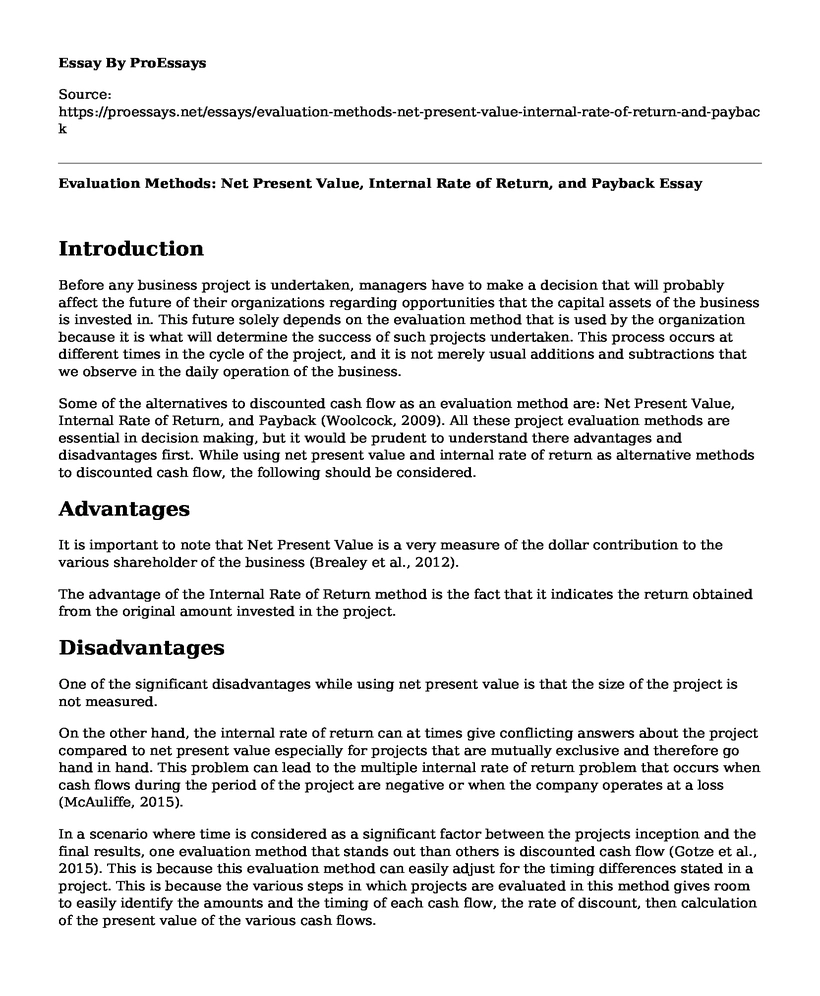Introduction
Before any business project is undertaken, managers have to make a decision that will probably affect the future of their organizations regarding opportunities that the capital assets of the business is invested in. This future solely depends on the evaluation method that is used by the organization because it is what will determine the success of such projects undertaken. This process occurs at different times in the cycle of the project, and it is not merely usual additions and subtractions that we observe in the daily operation of the business.
Some of the alternatives to discounted cash flow as an evaluation method are: Net Present Value, Internal Rate of Return, and Payback (Woolcock, 2009). All these project evaluation methods are essential in decision making, but it would be prudent to understand there advantages and disadvantages first. While using net present value and internal rate of return as alternative methods to discounted cash flow, the following should be considered.
Advantages
It is important to note that Net Present Value is a very measure of the dollar contribution to the various shareholder of the business (Brealey et al., 2012).
The advantage of the Internal Rate of Return method is the fact that it indicates the return obtained from the original amount invested in the project.
Disadvantages
One of the significant disadvantages while using net present value is that the size of the project is not measured.
On the other hand, the internal rate of return can at times give conflicting answers about the project compared to net present value especially for projects that are mutually exclusive and therefore go hand in hand. This problem can lead to the multiple internal rate of return problem that occurs when cash flows during the period of the project are negative or when the company operates at a loss (McAuliffe, 2015).
In a scenario where time is considered as a significant factor between the projects inception and the final results, one evaluation method that stands out than others is discounted cash flow (Gotze et al., 2015). This is because this evaluation method can easily adjust for the timing differences stated in a project. This is because the various steps in which projects are evaluated in this method gives room to easily identify the amounts and the timing of each cash flow, the rate of discount, then calculation of the present value of the various cash flows.
References
Brealey, R. A., Myers, S. C., & Marcus, A. J. (2012). Fundamentals of corporate finance. McGraw-Hill/Irwin.
Gotze, U., Northcott, D., & Schuster, P. (2015). Discounted Cash Flow Methods. In Investment Appraisal (pp. 47-83). Springer, Berlin, Heidelberg.
McAuliffe, R. E. (2015). Internal Rate of Return. Wiley Encyclopedia of Management, 1-1.
Woolcock, M. (2009). Toward a plurality of methods in project evaluation: a contextualized approach to understanding impact trajectories and efficacy. Journal of development effectiveness, 1(1), 1-14.
Cite this page
Evaluation Methods: Net Present Value, Internal Rate of Return, and Payback. (2022, Aug 12). Retrieved from https://proessays.net/essays/evaluation-methods-net-present-value-internal-rate-of-return-and-payback
If you are the original author of this essay and no longer wish to have it published on the ProEssays website, please click below to request its removal:
- Paper Example: Applicable Law to Electronic Contracts
- Research Paper on HarbourSide Hotel
- Essay Example on Employment Laws: Key Rules and Conflict Resolution
- UK Boutique Hotel Chain Expands to France & Germany - Essay Sample
- Essay Example on Small Biz Owner v. Entrepreneur: Who's Who?
- The Legacy of Maggie L. Walker: An Iconic Entrepreneur & Civil Rights Activist - Essay Sample
- Essay Example on Protect Vital Info: Establish Right to Retain Essential Data







